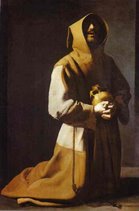
I dance for God. - Suzanne Farrell
For twenty years Suzanne Farrell was the muse of George Balanchine, the Dulcinea to his Don Quixote. (A brief biography of her, a 1990 interview, and photos can be found here.) She retired from performing ten years before I became interested in ballet, but in my readings and viewings she stood out as a central figure in the ballet boom. My ballet interest began with Nureyev and moved on towards the other great male Russian defector: Baryshnikov. It was while watching The Turning Point, an otherwise hopelessly soap opera-derived movie whose only merit is that it contains some great recordings of dance, that I first saw Suzanne Farrell move. And she moved like no one else. Her silhouette was distinctively different from other ballerinas, with her wider than normal - for a ballerina - hips and full thighs, but it's her quality of movement and musicality that are so striking. Joan Acocella described it in an interview a few years ago. Within her dancing is a complete mental, emotional, and physical absorption and commitment to the moment. Several writers commented that when she danced, she sometimes seemed to be having a religious experience; more than one compared her to St. Teresa of Avila for her nun-like purity that could transform into ecstasy while dancing a ballet like Concerto Barocco or Mozartiana. For the devoutly Catholic Ms. Farrell, worshipping God and dancing are probably the same activity.
She also stood out for her self-abnegation to George Balanchine's vision and her willingness to be his muse, to mold herself to his vision of a ballerina and of the dance. She saw herself and "Mr. B" as soulmates and believed that God destined them to be together in art; he seems to have felt similarly, calling her "the other half of my apple." That she also saw him as a God figure, instrumental to achieving transcendence through art, seems unmistakable. This despite his romantic pursuit of her, nevermind their 41-year difference in age or that he was married to his fourth wife during their five-year romantic involvement. They were never physical lovers; for her, spiritual consummation through art, through what happened in the studio and on the stage, was what was most important. The greatest use of the body was as an instrument of art in dance, not sex. She has continued in her devotion to her mentor, founding the Suzanne Farrell Ballet at the Kennedy Center in 1999 and dedicating her company to the preservation of Balanchine's choreography. As Laura Jacobs once wrote, "[Farrell] was never [Balanchine's] wife during his lifetime, but now she is the wife of his nights."
Luckily for you and me, last night the Suzanne Farrell Ballet gave a free, brief performance of rarely seen Balanchine choreography that was also webcast and archived! Watch it here (February 23, 2007).
The ballet excerpts performed are (program notes courtesy of posters on Ballet Talk):
Adagio from Concierto di Mozart (Second movement of Violin Concerto in A, K. 219 by Mozart)
performed by Ashley Hubbard and Matthew Prescott
Contrapuntal Blues Pas de deux from Clarinade (excerpt: Derivations for Clarinet and Jazz Band by Morton Gould)
performed by Elisabeth Holowchuk and Benjamin Lester; the female part was choreographed for Farrell in 1964.
Glinka Pas de deux Brillante, a section of Divertimento Brillante (themes from Bellini's La Sonnambula by Glinka)
performed by Bonnie Pickard and Neil Marshall
Variations for Orchestra (by Stravinsky)
performed by Shannon Parsley; this part was choreographed for Farrell in 1966 and revived for her in 1982.
Pas Classique Espanol Divertissements from Balanchine's Don Quixote (by N. Nabokov)
performed by:
Trio Gina Artese, Kristen Gallagher and Sara Ivan
Duet Elisabeth Holowchuk and Lisa Reneau
Solo Shannon Parsley
Pas de deux Natalia Magnicaballi and Kirk Henning
Ms. Farrell really deserves her own post - actually, several - from me, but I wanted to write this little bit and inform about the webcast. Read her autobiography, Holding on to the Air, or watch Elusive Muse for incredible footage of her dancing. She also, dancing-wise, is featured prominently in the PBS documentary Balanchine.
